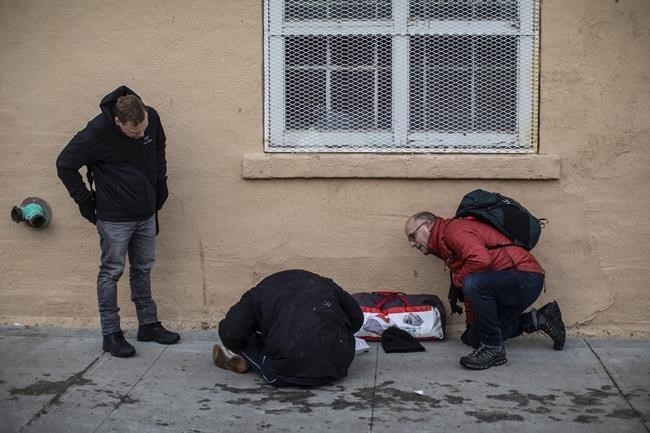The twinkling of festive lights in reds, greens and golds in Alberta's two major city centres is little comfort for thousands of unhoused people trying to survive another winter cold spell.
On a frigid December night in Calgary, shoppers carried presents along the downtown light-rail transit corridor, passing dozens of people huddling in doorways or near heated bus shelters.
Three people, surrounded with shopping carts, used cardboard boxes and an umbrella to try and stay warm. It was -28 C with wind chill.
Homeless shelters are near capacity but open their doors to all when temperatures become unbearable. Still, some choose to stay outside.
Dakota Casey said it's safer that way.
"I've had food stolen, my phone stolen out of my pocket. I have had money go missing and people have taken my boots while I'm sleeping, my backpack from under my head," he told The Canadian Press.
Casey and his husband, Nathan Lunn, know there are dangers sleeping rough, too, and take turns staying awake to stay safe.
The unrelenting chill is a constant threat. Casey was treated recently for frostbite on his hands.
A tent donated by the not-for-profit relief agency BeTheChangeYYC will make living outside slightly better, Casey said.
"Right now it's just survival ... if I sleep in a tent for Christmas and I have to use motor oil for heat, you know what? That and my husband is all I really care about having."
Chaz Smith, founder of BeTheChangeYYC, was once homeless himself. His team has helped more than 15,000 people this year with warming and emergency supplies.
"It's extremely dangerous, especially if you get a little bit wet," said Smith. "They're people, too, and they deserve housing. They deserve heat. No one deserves to be out here and get frostbite and amputations and die outside in the cold."
Tim Richter, CEO of the Canadian Alliance to End Homelessness, said the homeless sector has been battered over the last two years and now the Omicron COVID-19 variant poses greater risk.
He said homeless camps are growing across Canada and there are more people without housing. There are also compounding crises as housing affordability deteriorates and drug overdose deaths spike.
We're at the point of "peril or promise," said Richter. Either the varied threats continue to drive homelessness, or communities and multiple levels of government follow through on promises to address the challenge.
In October last year, Ottawa announced $500 million for rapid housing in 15 Canadian cities, including Edmonton and Calgary. That showed how fast support can be provided, said Richter.
Both Alberta cities also are to see funding from the provincial government. The province said in November it would be spending $21.5 million to ease capacity issues at homeless and women's shelters.
This month, Calgary city council approved $750,000 in emergency funds to help the homeless.
Commitments must not only be maintained but expanded to urgently address the growing crisis, said Richter. Otherwise peril will prevail.
In Edmonton, freezing rain that pelted the city in early December turned green spots where unhoused people had pitched tents hard and icy.
In the bush of a river valley park, a tarp hung over a fallen tree branch. Ice made it difficult for an outreach worker from Boyle Street Community Services to climb up the hill to check on potential occupants.
No one was inside as DougCooke peeled back one side of a tent. Someone's belongings were scattered on a foam mattress and in the surrounding snow. Clothing, cigarettes and food packages were frozen to the ground.
There were similar setups propped up downtown. A man with a blanket draped over his head sat near vents pushing out warm air.
Jared Tkachuk, senior programs manager at Boyle Street, said COVID-19 has cut space at shelters, leaving hundreds unable to find refuge, including an influx of people experiencing homelessness for the first time after losing jobs during the pandemic.
The risk of dying outside is high and some lives have already been lost, if not by freezing, then by fires ignited to keep warm, said Tkachuk. Gangs also prey on camps.
"Houselessness can be solved with housing. If those people get four walls and a roof above their head ... they'll be OK," he said.
"But a lot of the folks that outreach teams are working with, who are sleeping outside for years ... (they) are actually looking for a home. They're looking for a community."
It's not just an urban problem, said Dean Kurpjuweit, executive director of the Mustard Seed, a not-for-profit supporting the poor and homeless in Edmonton.
He said the pandemic has exposed a lack of funding and services in certain jurisdictions, especially rural areas.
In Wetaskiwin, southeast of Edmonton, that scarcity delayed the opening of a warming shelter while dozens slept in an open field camp.
"I'm pleased with the Band-Aids that have been put into place, but that's not going to fix the long-term problem," said Kurpjuweit, who fears increased support during COVID-19 will fade as a semblance of normalcy returns.
"If our homeless population across the province doubled, if not tripled, what are we doing to turn that around?"
This report by The Canadian Press was first published Dec. 22, 2021.
Alanna Smith and Bill Graveland, The Canadian Press



